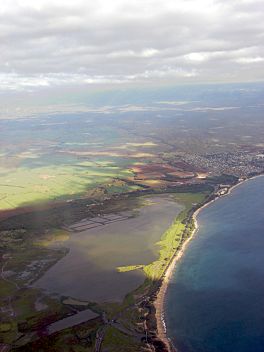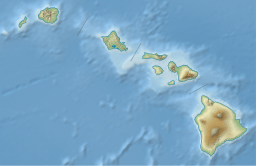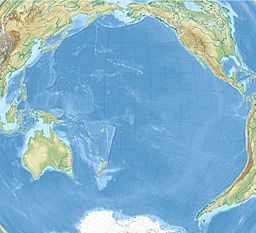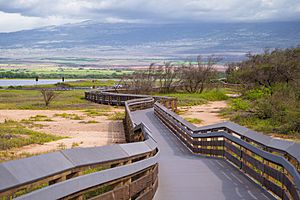Kealia Pond National Wildlife Refuge facts for kids
Quick facts for kids Kealia Pond |
|
|---|---|

Aerial view
|
|
| Location | Maui, Hawaiʻi |
| Coordinates | 20°47′50″N 156°28′42″W / 20.79722°N 156.47833°W |
| Type | coastal wetland, salt marsh |
| Catchment area | 56 sq mi (150 km2) |
| Basin countries | United States |
| Surface area | 200 acres (81 ha), 450 acres (180 ha) (winter) |
The Kealia Pond National Wildlife Refuge is a special place for nature on the island of Maui in Hawaiʻi. It is a coastal salt marsh, which means it is a wet, marshy area near the ocean with salty water. You can find it between the towns of Kīhei and Māʻalaea.
This refuge is a safe home for many birds. It covers about 691 acres and protects 30 different kinds of waterfowl and shorebirds. Many migratory ducks also visit. Some of the special birds living here include the ʻaukuʻu (which is a black-crowned night heron). You can also find endangered birds like the āeʻo (also known as the Hawaiian stilt) and the ʻalae kea (the Hawaiian coot).
Kealia Pond was first chosen as a wildlife refuge in 1953. It started with 300 acres of protected land. Later, in 1992, it became part of the larger National Wildlife Refuge System. This system helps protect important natural areas all across the United States.
About Kealia Pond
Kealia Pond changes a lot throughout the year. During the rainy winter, the pond gets much bigger. It can grow to more than 400 acres. This is when the water levels are highest.
As spring arrives, the water starts to dry up. By summer, the pond shrinks to about half its winter size. This leaves behind a lot of salt. That is why it is called "Kealia," which means "salt encrusted place" in Hawaiian. Long ago, people even made salt from the seawater here.
When the water levels get very low, many fish in the pond, like tilapia, might die. This is a natural part of the pond's cycle.
History of the Pond
Kealia Pond was once an ancient fishpond. Native Hawaiians used water from the Waikapu Stream and Kolaloa Gulch to fill it. They might have raised fish like awa (milkfish) and amaʻama (flathead mullet). They used a clever system of ditches and sluice gates to let fish from Māʻalaea Beach swim into the pond.
The area near Kealia Pond also has a history. To the west, there are other shallow ponds and mudflats. Birds use these areas during the winter and spring when they are flooded. When these mudflats dry out in the summer, the birds move back to Kealia Pond.
This western area was once an airport runway. It was one of Maui's first airports, called Māʻalaea Airport. During World War II, Kealia Pond was even used for training. The 2nd and 4th Marine Divisions of the United States military trained there.
Rare Bird Visitors
Kealia Pond is a great spot for birdwatching. Many different kinds of birds visit this special place. Sometimes, rare birds that are not usually seen in Hawaii stop by. These "vagrant" birds include the Garganey, Curlew Sandpiper, Marbled Godwit, American Avocet, Spotted Sandpiper, and Eared Grebe.
The Boardwalk
There is a nice boardwalk at Kealia Pond. It opened on September 8, 2009, and has a parking lot for visitors. The boardwalk is next to Sugar Beach, between Kīhei and Māʻalaea. It is a great place to walk and observe the birds and nature. The boardwalk is open from 6 a.m. to 7 p.m. every day.
Images for kids
-
Cyperus laevigatus growing at the pond







